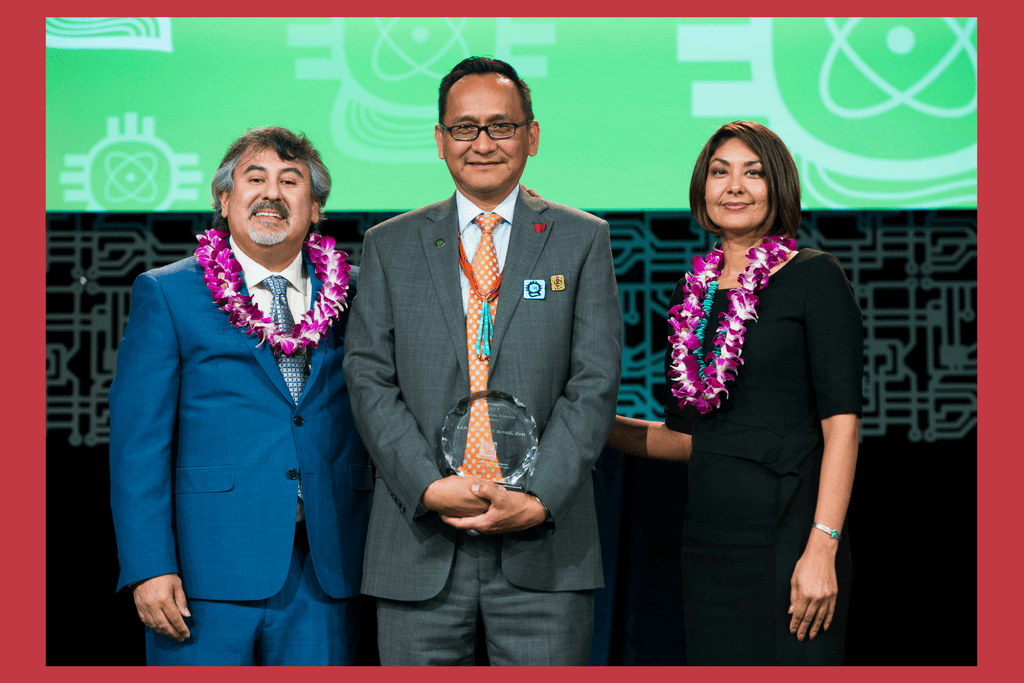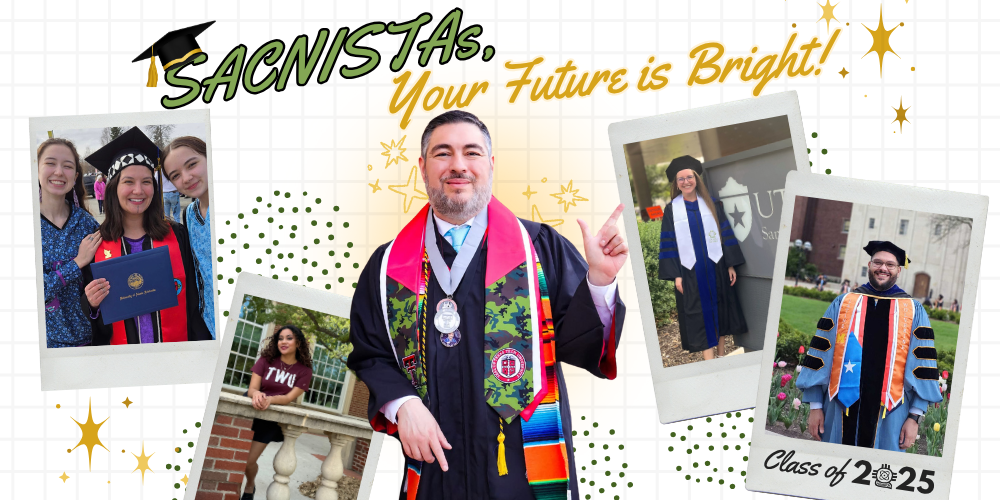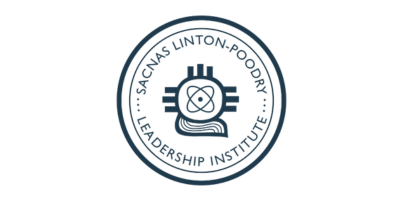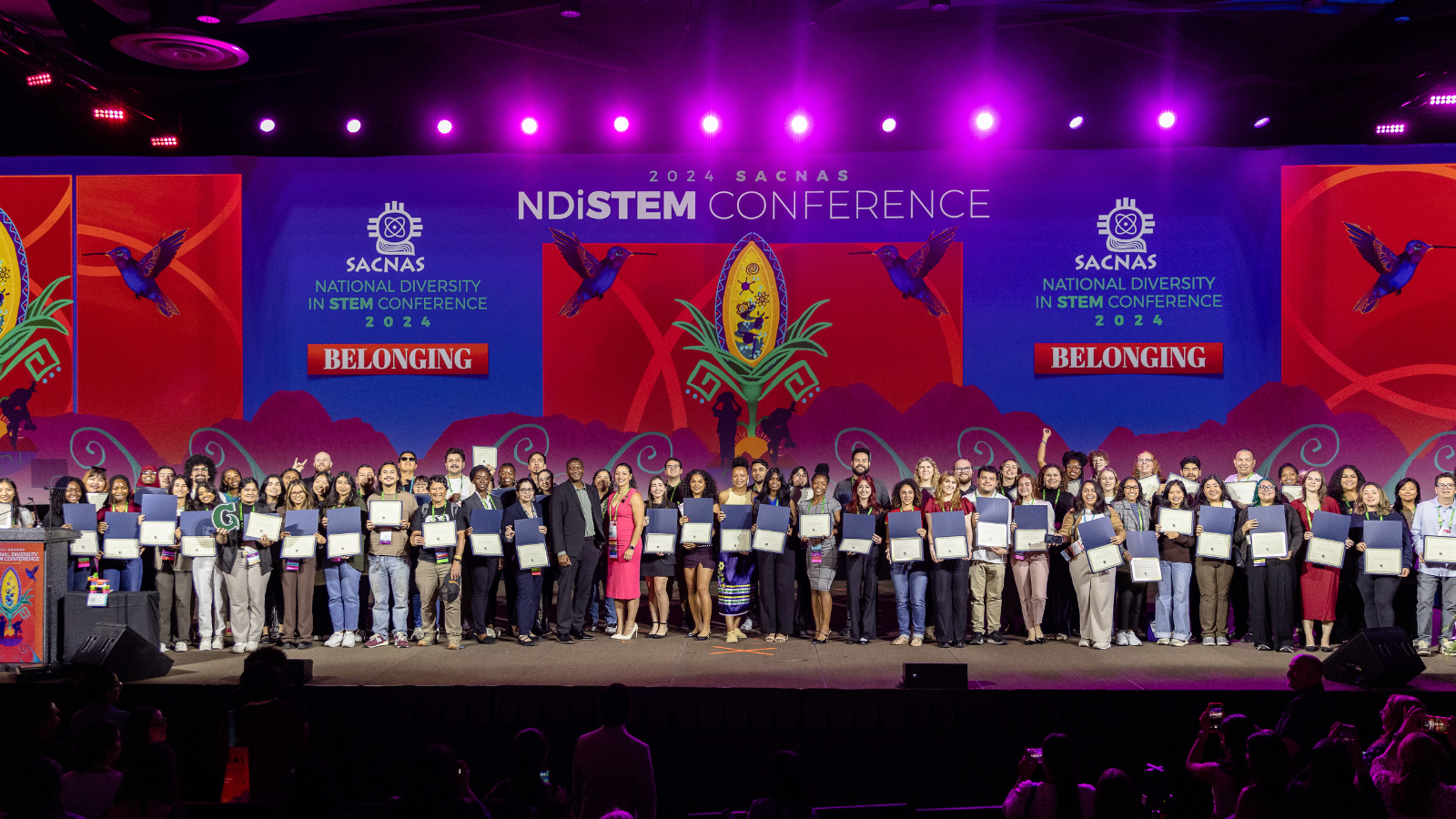Dr. Bitsóí (middle) after receiving award at the 2017 SACNAS conference. Left: SACNAS President Dr. Lino Gonzalez. Right: SACNAS Executive Director Dr. Antonia Franco
Outstanding SACNISTA LeManuel Lee Bitsóí (Diné), EdD was recently honored with the SACNAS Presidential Service Award at the 2017 SACNAS conference October 19-21 in Salt Lake City, Utah for his years of continued contributions to the society. Selected by SACNAS President Dr. Lino Gonzalez, Bitsóí, who is Stony Brook University’s Chief Diversity Officer, has remained a steadfast champion for his people and a prominent SACNAS leader to ensure Native American participation in STEM.
“[My participation with SACNAS] certainly has been an interesting ride and a great learning experience. It’s a labor of love and something that I believe in. I am dedicated to increasing the level of participation by Native Americans within SACNAS, but also serving as a voice for indigenous people in general,” said Bitsóí during his Q&A with Dr. Gonzalez.
Gonzalez: How did you first get involved with SACNAS?
Bitsóí: I first got involved with SACNAS when I was working at Dartmouth College as the Assistant Director of Admissions and Financial Aid. It was there that I chose SACNAS as a recruiting venue for Dartmouth. I became even more curious about SACNAS’ commitment to Native Americans after seeing the poster presentations at that particular conference.
Gonzalez: How has your leadership with SACNAS grown and evolved? What committees have you served on?
Bitsóí: I was a member of the inaugural class of the Linton-Poodry SACNAS Leadership Institute (LPSLI) in 2009 while I was as a research faculty member. Upon graduating from the leadership institute, I took the plunge to run for the SACNAS Board of Directors, and served on the board from 2010-2013. Then I became a member of the Native American Affairs Committee (NAAC) and was eventually appointed as a chair for the NAAC. I was also on the interview committee when Dr. Antonia Franco was selected as the Executive Director.
It certainly has been an interesting ride and a great learning experience. It’s a labor of love and something that I believe in. I am dedicated to increasing the level of participation by Native Americans within SACNAS, but also serving as a voice for indigenous people in general.
As you know, I will take a stand when it comes to my community and that’s part of my brand. I also think part of it is helping people to understand Native American communities. It’s about sovereignty for tribal nations as we have government-to-government relationships at the federal, state, county and city levels. There’s always this constant educating process that needs to take place for people to understand the specialized needs Native Americans have. Not only within SACNAS, but within society in general.
Gonzalez: What are some other contributions you’ve made to increase Native American participation in STEM that you’re proud of?
Bitsóí: At Dartmouth, I had the opportunity to pick and choose what venues I could recruit at. I was able to expand beyond the traditional targeted approaches the college had in place and reached out to AISES, SACNAS and other minority conferences. When I transitioned back to Harvard, I was able to implement a recruitment plan for Native American students for all of the faculties (undergraduate, graduate and professional schools). What you see now, the way that Harvard has laid out their booths, all in a row, is part of the work I was involved in. Having a more concentrated effort around the recruitment of Native Americans was important, and it also carried over to other underrepresented minority communities as well.
Gonzalez: How do you think SACNAS has influenced you? What has SACNAS given to you?
Bitsóí: SACNAS has been a conduit of information for me. I’ve been able to develop a network of people coming from all backgrounds; not only native, but non-native as well. As SACNAS has evolved, the membership is even more diverse than it was when I first attended and have made many connections through SACNAS. SACNAS has played a role in my professional development through LPSLI – where I really had to review the trajectory of my career. When I attended LPSLI, it was timely for my participation, as I had left Harvard to pursue a research faculty position elsewhere.
After I was the co-investigator for an indigenous genomics working group and committee, I went in for my review and the department chair asked me to explain what I was doing. I said, “this is about bioethics and ethical and legal and social implications of genetic genomic research within indigenous populations.” I explained it very clearly. The Chair looked at me and said, “well, that’s very noble of you to want to assist your community and other underserved populations, but I’m just going to be candid with you and tell you that we do real science around here, so you’re going to have to get on board with one of these projects.” I was stunned.
What helped me through this ordeal was relying on people in the SACNAS network. I reached out to SACNISTAs and asked them if they’ve ever encountered a department chair like this and if so, how did they handle it? People provided some really solid advice and words of encouragement and support, so that’s what helped me get through this experience. It’s that type of camaraderie and family that emanates and permeates the society itself. That’s what’s extremely helpful because we look out for each other. There’s authenticity here, there’s integrity here.
Gonzalez: In any of the institutional roles that you’ve had, have you interacted with SACNAS students at those institutions as an advisor, as a mentor? Outside the conference, do you maintain relationships with SACNAS members?
Bitsóí: Yes I do. In my previous position at Rush University Medical Center in Chicago, there were some people who were interested in SACNAS, but didn’t know how to become connected to the organization. Subsequently, on the recruiting end, I was able to convince our PhD program director to come to SACNAS and tap into the talent pool there. The number of students who were engaged with SACNAS at Rush were minimal; however, I kept in communication with students at other universities in Chicago. In my role as Chief Diversity Officer at Stony Brook University, I keep in contact with SACNISTAs, not only at Stony Brook but at other institutions as well.
Gonzalez: What’s the most important thing that keeps you committed to SACNAS? What keeps you coming back to the conference every year?
Bitsóí: It’s a sense of community. It’s kind of like a family reunion. I equate it as such because some of the relationships I’ve built and maintained have come from different networks within SACNAS. It’s always a joy to return, to exchange notes, to catch up, to share a meal, and to celebrate. Aside from that, I think it’s important for me to be present. It’s also a sense of “noblesse oblige,” this noble obligation, to help my community. I say that because this organization is dedicated to the Advancement of Chicanos, Hispanics and Native Americans in Science. We have to go back to the origins of our Society and we always have to be cognizant of that. There’s so much intersectionality between Chicanos and Native Americans, more than people are aware of. But the people who started the organization were very much aware of that. We have to stay the course. Leadership teams come and go, and in the time that I’ve been involved with SACNAS, it’s important to have that voice. What keeps me engaged is the sense of family and its evolving mission to broaden participation of underserved and underrepresented people.



